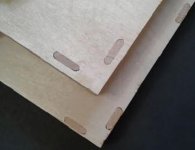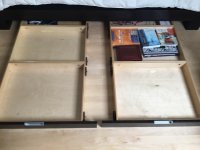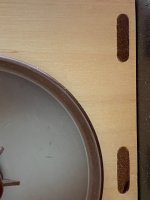Hello all, new poster here. Thank you all for helping create this terrific resource.
I am in the planning stages for a large bedroom built-in mostly consisting of various sized drawers. For a variety of reasons, weight is major consideration. Before figuring out the carcass, I'd like to tackle the drawer box design because that is the bulk of the build. The drawer dimensions will range from ~15" to ~30" wide, from ~6" to ~12" high, and in all cases 15" deep. They must be able to contain light to moderate weight household items (clothing, etc.). I'm looking for the lightest materials which a small, traditionally outfitted workshop can hope to use for these drawers.
For drawer box construction: I have in the past used 9mm (~3/8") baltic birch for the sides of drawer boxes that were slightly smaller in dimension than those called for here. In that application, I used a captured 6mm BB bottom glued in the dado, and glued butt joints with two 4mm through dominos on each joint. (I note this thread on similar work: Post). I found the drawers to be quite sturdy, even if still relatively hefty. I did get minor tearout when cutting the through dominos (perhaps 1 in 10 had the issue), which was frustrating but manifested for me regardless of plunge direction and patience. Despite this, the overall effect was still quite nice, even if imperfect.
Does anyone have experience with alternative materials or methods of constructing sturdy drawer boxes of this size? Any alternative material to the high weight of BB? I can't imagine going down to 6mm for this size, but has anyone tried, and if so, what is the joint? Any Confirmat experience with thin ply? I'm open to outside the box, off the wall, or really anything this great group has to offer as far as material and methods go.
I'm fresh out of ideas and am close to settling on a repeat of my 9mm/through domino version, so I'm hoping someone has something to toss out as an option. Thanks in advance.
I am in the planning stages for a large bedroom built-in mostly consisting of various sized drawers. For a variety of reasons, weight is major consideration. Before figuring out the carcass, I'd like to tackle the drawer box design because that is the bulk of the build. The drawer dimensions will range from ~15" to ~30" wide, from ~6" to ~12" high, and in all cases 15" deep. They must be able to contain light to moderate weight household items (clothing, etc.). I'm looking for the lightest materials which a small, traditionally outfitted workshop can hope to use for these drawers.
For drawer box construction: I have in the past used 9mm (~3/8") baltic birch for the sides of drawer boxes that were slightly smaller in dimension than those called for here. In that application, I used a captured 6mm BB bottom glued in the dado, and glued butt joints with two 4mm through dominos on each joint. (I note this thread on similar work: Post). I found the drawers to be quite sturdy, even if still relatively hefty. I did get minor tearout when cutting the through dominos (perhaps 1 in 10 had the issue), which was frustrating but manifested for me regardless of plunge direction and patience. Despite this, the overall effect was still quite nice, even if imperfect.
Does anyone have experience with alternative materials or methods of constructing sturdy drawer boxes of this size? Any alternative material to the high weight of BB? I can't imagine going down to 6mm for this size, but has anyone tried, and if so, what is the joint? Any Confirmat experience with thin ply? I'm open to outside the box, off the wall, or really anything this great group has to offer as far as material and methods go.
I'm fresh out of ideas and am close to settling on a repeat of my 9mm/through domino version, so I'm hoping someone has something to toss out as an option. Thanks in advance.





